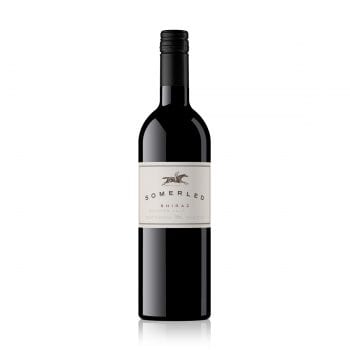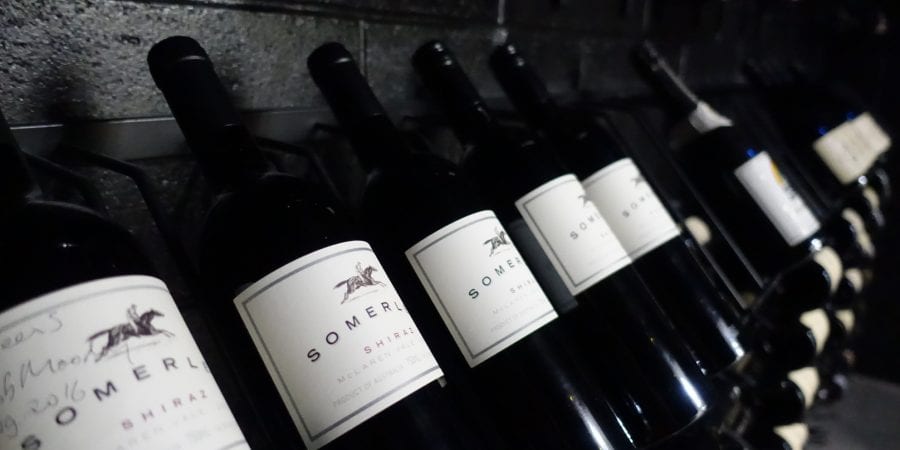Exciting news from the bottling line this week… our 2016 Shiraz has been safely tucked away for you to drink, purchase and ferret away in your cellar in about 18 months to 2 years time!
I know, I know! It’s a ridiculously long time to wait, but perfection takes time people (and we’ve got the rest of the 2014 and the release for the 2015 to get through first)!
But I can assure you, it is definitely worth waiting for. Rob shared a sample of it last week. There was a lot of “Oh wow… that’s VERY Somerled isn’t it?!” bandied around, but even the humble man himself agrees it’s pretty fantastic.

4200 litres of the scrumptious stuff was bottled at Boutique Bottlers in the Barossa on Wednesday (at this stage without labels). Rob chooses to use a beautiful “Bordeaux” style bottle. If you haven’t seen the new bottles we’ve been using for the 2014 (and subsequent) vintages, check it out. Rob loves the look of them… heavy, elegant and fitting for a premium wine.
It’s a little out of the norm for a Shiraz though. Shiraz is typically bottled in a “Burgundy” style bottle (you know… the ones with the sloping shoulder). But Rob likes these ones better and we think it looks pretty schmick!
And we should all know by now that Rob has changed from using cork to screw caps on his Shiraz. But that’s a whole topic on its own… I’ll get into that another day.
Good news for Sparkling Shiraz fans…
Rob had a cheeky 600 litres left over after bottling the standard Shiraz volume. So, of course, Rob has used it for a 2016 Sparkling Shiraz!
He will leave that in barrel for another few months for some further maturation. According to Rob the absolute essence of sparkling red is to have a maturity of flavours, complexity and softness. Sparkling wines tend to mature more slowly so it will need this extra few months in barrel to create the style of sparkling red Rob is becoming known for.
Early next year he will go through the process of turning it into Sparkling. It will be the next vintage off the blocks once we run out of our current 2014 (I don’t want to cause a panic, but you should really get yours now!)
What happens between now and when it’s released?
It will be stored at our distribution partner Wineworks in Lonsdale. They have huge warehouses set at around 16-18 degrees. And even on a 36-degree day like today there is very little fluctuation in temperature. A perfect place for 5 pallets-worth of the good stuff to spend the next few years.
Once it’s ready to be released, Wineworks will help us label it and deliver it to the cellar bar. No doubt in time for a pre-release to our Jockey Club members.
Bottle shock
Other than a really terrible movie (the opinions of the writer may not be those of Somerled Wines and its affiliates), what is bottle shock?
“Bottle shock” or “bottle sickness” are terms used to describe a temporary condition in a wine where its flavours are muted or disjointed. The evidence for this phenomenon is more anecdotal than scientific, but the theory is that all the complex elements in wine (phenolics, tannins and compounds) are constantly evolving, both on their own and in relation to each other. Heat or motion can add stress to this evolution, causing the wine to shut down temporarily. There are two main scenarios when bottle shock sets in: either right after bottling, or when wines (especially fragile older wines) are shaken in travel. (thanks Wine Spectator)
Rob has never really seen any evidence of bottle shock in his wines. In his personal opinion, Rob attributes the phenomenon to one or a combination of these possible scenarios:
- perhaps back when machinery wasn’t so sophisticated, more air was allowed into the wine during the bottling process
- Wines that are less stable to begin with may take longer to reach equilibrium
- Wines which require last-minute corrections may be more affected
He thinks that it could have more to do with poor technique before bottling than anything that happens on the bottling line itself.
How to avoid a “very disappointing result”
If his wine tasted sub-standard after bottling, Rob would call this a “very disappointing result”. Therefore, he takes every precaution to ensure the wine he sent from the winery, remains in optimum condition right through the bottling process.
To ensure this is the case, he will do one final analysis of the wine at Boutique Bottlers just before it heads down the line.
As soon as he’s happy, Rob hands it over to the experienced hands of Kym Burgermeister who personally oversees each bottling.
Rob then takes a case home, so he can just double check the quality with some additional home-based research!
This wine has been on quite a journey. From McLaren Vale to the winery in the Adelaide Hills. Then to the Barossa for bottling and back to the southern suburbs of Adelaide for storage. Eventually, it will find its way to Hahndorf and into your homes!
